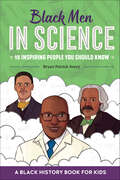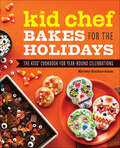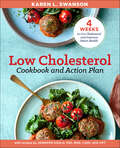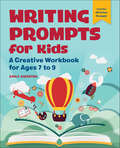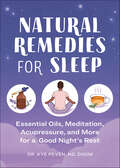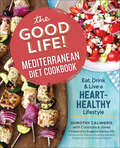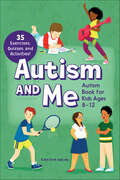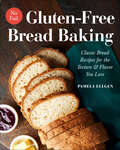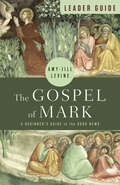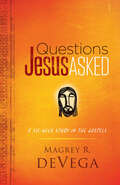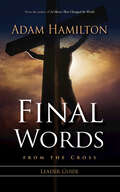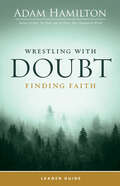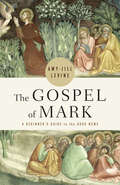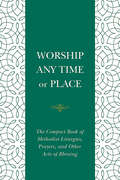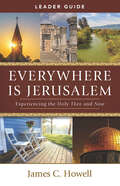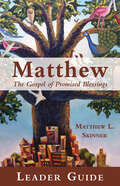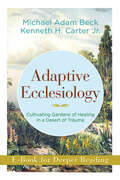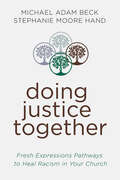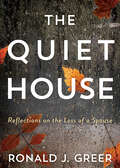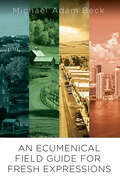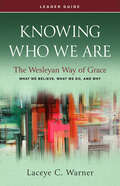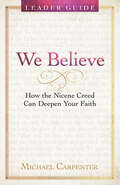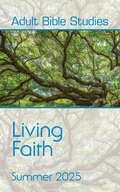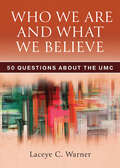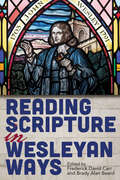- Table View
- List View
Black Men in Science: 15 Inspiring People You Should Know (Biographies for Kids)
by Bryan Patrick AveryIncredible stories of Black men who changed the course of science—for kids ages 8 to 12 All throughout history, Black men have made important contributions to scientific discovery. This collection of biographies for kids explores 15 of these intelligent men and the extraordinary scientific accomplishments they achieved—even when they faced huge challenges. You'll learn how they stood up against racism and inequality, and never stopped following their passions for science, technology, engineering, and mathematics.Meet talented Black men in history who have helped:Explore our world—Discover inventors like Lewis Howard Latimer and biologists like George Washington Carver, and find out how they expanded our understanding of the world around us.Advance medicine—Learn the stories of doctors like James McCune Smith and Leonidas Berry who helped stop the spread of disease and change the way we perform surgery.Change the game—Find out how people like geneticist Rick Kittles and engineer Roy L. Clay Sr. are still doing important research and breaking barriers.Dive into a world of inspiring men with this scientific entry into Black history books for kids.
Kid Chef Bakes for the Holidays: The Kids' Cookbook for Year-Round Celebrations (Kid Chef)
by Kristy Richardson50 Fun baking creations for kids 8 to 12—for holiday cheer all year-round!Want to learn how to make your own holiday treats? It just takes a little practice! Bursting with delicious recipes perfect for young bakers, Kid Chef Bakes for the Holidays makes sure you've got something tasty to share at every special occasion.Discover dozens of sweets perfect for events all across the seasons! Get a complete kids cookbook that helps you grow your skills and become an expert baker. There's tons of guidance and advice that'll help kids and parents learn about everything from baking safety to frosting with flair.This festive kids cookbook includes:50 Holiday treats—Whether it's Christmas Cutout Cookies, Ultimate Memorial Day Pound Cake, or Eid Moon Cookies, this kids cookbook makes sure you're ready to serve up sweetness at all kinds of special events.Instructions for young bakers—This kids cookbook is full of recipes that have easy-to-follow directions that work whether it's your first time in the kitchen or you've already made a few cakes.Helpful advice—Get handy explanations of measuring, mixing, cutting, and more—plus troubleshooting tips for when things go a little wrong.Holidays have never been more delicious than with this awesome kids cookbook!
Low Cholesterol Cookbook and Action Plan: 4 Weeks to Cut Cholesterol and Improve Heart Health
by Jennifer Koslo Karen L SwansonEat smarter and boost your heart health with this low cholesterol cookbook and action planSwitching to a new heart-healthy diet can seem like a daunting task. That's why cardiac dietitian, Jennifer Koslo, and Go Low Cholesterol blogger, Karen Swanson, created The Low Cholesterol Cookbook and Action Plan. With an easy-to-follow 4-week program, this low cholesterol cookbook delivers comprehensive recipes and a proactive meal plan that can help you eliminate bad fats without missing out on the delectable flavors you crave.From Slow Cooker Hawaiian Chicken to Veggie Chili, this complete low cholesterol cookbook gives you everything you need to start cooking up a storm. Get expert tips for shopping and creating food lists, plus suggestions for exercising regularly, and more.The Low Cholesterol Cookbook and Action Plan goes beyond your basic low cholesterol cookbook with:120 Heart-healthy recipes—Discover dozens of low cholesterol takes on your favorite foods like Banana-Oat Pancakes, Honey Mustard Chicken, and Flourless Chocolate Cookies.A 4-week meal plan—Get on the right path to lowering cholesterol in one month with this sensible action plan.Fast and flavorful dishes—Most meals take 30 minutes or less to prepare and use only 5 key ingredients.Embrace a new health-conscious way of eating with The Low Cholesterol Cookbook and Action Plan.
Writing Prompts for Kids: A Creative Workbook for Ages 7 to 9
by Emily AierstokInspire kids to bring their ideas to life with creative story prompts for ages 7 to 9The world's best authors all have one thing in common: practice! This workbook features 60 fun writing prompts for kids that will help them build their writing skills and explore new ideas. With each one, they'll spark their curiosity and creativity as they craft original stories with confidence. 60 awesome writing prompts—From superheroes to time travel to floating castles, kids can try their hand at story starters that push the limits of their imagination. Tips for better storytelling—Kids will discover what makes a good story, including character development, narrative structure, and unique settings. Encouraging messages—Motivational advice helps kids continue developing their voice and talents! Supercharge your child's storytelling skills with this guide to creative writing for kids.
Natural Remedies for Sleep: Essential Oils, Meditation, Acupressure, and More for a Good Night's Rest
by Kye PevenDiscover non-pharmaceutical solutions for better sleepA good night's sleep can do wonders for your physical and mental health. But if you struggle with falling or staying asleep, your frustration may have you looking to sleep medicine for help. This natural remedies book will show you a better way. Natural Remedies for Sleep provides the knowledge, tools, and natural solutions for how to sleep smarter. Explore why we sleep, along with cognitive behavioral therapy (CBT) techniques, meditation, essential oils, acupressure, and more to help you get the full, consistent rest you deserve.Sleep 101—Learn the basics of what good sleep is, why we need it, some common sleep issues, and the short- and long-term benefits of a dependable night's sleep.Sleep tool kit—Good sleep takes planning—discover a list of the resources and items you need for getting a better night's sleep, and creating a smart sleep routine for yourself.Sleep scenarios—Find suggested natural sleep remedies for adults and techniques for overcoming a range of sleep problems and scenarios, such as insomnia, interrupted sleep patterns, and digestion issues.Fall asleep and stay asleep with the helpful and all-natural techniques and resources in this empathetic book.
The Good Life! Mediterranean Diet Cookbook: Eat, Drink & Live a Heart-Healthy Lifestyle
by Constance Jones Dorothy CalimerisThe Mediterranean diet is not just about food, but also about a lifestyle that has proven to be beneficial in reducing disease. Accordingly, The Good Life! Mediterranean Diet Cookbook introduces healthy and nutritious eating patterns, as well as also the day-to-day practices of the people of the Mediterranean.Dorothy Calameris, bestselling author of The Anti-Inflammatory Diet & Action Plans, grew up eating the Mediterranean foods of her Greek-American family long before doctors were recommending it as a heart-healthy "diet. Buttery olives, creamy yogurt, and colorful vegetables were staples of everyday meals, while roasted meats, wine, and sweets were enjoyed in moderation. Today Dorothy realizes how good life was back then and how vital it is to make the right food choices now.With simple recipes that use affordable, easy to find ingredients, it's easier than ever to bring the heart-healthy benefits of the Mediterranean diet to your table every day of the week!Stay focused with recipes that adhere to the core principles of the Mediterranean diet eatingStress less by making recipes ahead of mealtime for healthy heat-and-eat optionsGet creative when cooking for those with allergies by following tips for allergen-friendly optionsShop smarter with Dorothy's advice for buying and storing Mediterranean diet essentialsSavor each moment as you slow down your busy life and practice the Mediterranean diet's low-stress lifestyle
Autism and Me: Autism Book for Kids Ages 8–12
by Katie CookHelp children understand their autism and thrive with this positive guide for kids ages 8 to 12 We all think differently. This notion is celebrated in Autism and Me, a guide that helps children with autism spectrum disorder (ASD) gain a better understanding of how their brain works. The book highlights positive ASD traits while showing kids how they can work through some of its challenges as well.Unlike some other autism books for kids, this guide offers: Awesome activities—Interactive exercises encourage kids to apply the concepts discussed in a fun, low-stakes way, from fill-in-the-blanks and multiple choice quizzes to drawing and coloring.Proven strategies—From improving communication skills to developing self-care habits, kids will find strategies to help them better navigate school, social functions, and family life.True stories—Each chapter begins with real life anecdotes, offering relatable experiences from others on the autism spectrum and helping kids feel less alone.Kids will learn to manage emotions, make friends, and flourish with this strengths-based autism book.
No-Fail Gluten-Free Bread Baking: Classic Bread Recipes for the Texture & Flavor You Love
by Pamela EllgenNo-Fail Gluten-Free Bread Baking is your go-to guide for fool proof, everyday recipes with the taste and feel of real wheat bread.Baking the perfect loaf of gluten-free bread is tricky. But before you make another dud recipe or give up entirely, raise your expectations—you are going to make really good bread. With the No-Fail Gluten-Free Bread Baking cookbook, you can forget about your failed attempts, and finally fill your kitchen with the aroma of freshly baked bread that is truly gluten-free.From classic sandwich breads to bagels to pizza crust, this gluten-free cookbook provides you with fool-proof techniques and recipes to make gluten-free bread with the texture and taste of traditional bread. Complete with recipe tutorials and a troubleshooting guide for common gluten-free baking problems, No-Fail Gluten-Free Bread Baking is your answer to making bread that rises with your expectations.No-Fail Gluten-Free Bread Baking eliminates the uncertainty of gluten-free baking with:Recipe Tutorials that provide detailed, step-by-step guidance on how to make your first loaves of classic sandwich bread, French baguette, dinner rolls, artisan pizza crust, and banana breadA No-Fail Guide for troubleshooting the most common mistakes in gluten-free bakingOver 50 Recipes for sandwich breads, artisan breads, rolls, bagels, flatbreads, pizza, quick breads, and sweetbreadsNo-Fail Gluten-Free Bread Baking helps you avoid common mistakes in gluten-free baking with tried-and-tested recipes for bread that you won't believe is actually gluten-free.
The Gospel of Mark Leader Guide: A Beginner's Guide to the Good News
by Amy-Jill LevineDiscover the Good News in the Bible’s earliest GospelWalk through the Bible’s earliest source for the life of Jesus with scholar Amy-Jill Levine as she examines John the Baptizer, the Little Apocalypse, the Transfiguration, and several of Jesus's most notable stories and parables. The Good News of the gospel message comes alive in this book as readers see Jesus as divine and human, powerful and weak, approachable yet mysterious. The book features an in-depth study of select passages and illuminates the Gospel in its historical context and as a source for the other gospels.This comprehensive Leader Guide contains everything needed to guide a group through the study.Additional components for this 6-week study include the book, The Gospel of Mark: A Beginner’s Guide to the Good News, and DVD/Video sessions featuring Amy-Jill Levine (with closed captioning).
Questions Jesus Asked: A Six-Week Study in the Gospels
by Magrey deVegaWhat does Jesus want to know about us?Jesus was fond of asking questions, many of which cut right to the heart of what it means to be human. Why are you terrified? What do you live for? Who do you say that I am? In Questions Jesus Asked, author Magrey deVega explores six of the most provocative questions Jesus posed to others and guides us in answering them for ourselves.Asking these questions takes courage. Not only do they reveal what Jesus really cares about, they open a window into our hearts. We all have questions for God, but growth happens when we turn things around and ask what Jesus wants to know about us. When we dare to raise them, these questions bring us a fuller appreciation for the wisdom, power, and presence of God in our lives. Are you willing to step out in faith? Are you ready to answer the questions Jesus asked?The book can be read alone or used by small groups, and can be used anytime throughout the year. Additional components include video teaching sessions featuring Magrey deVega, and a comprehensive leader guide, making this perfect as a six-week group study done throughout the year.
Final Words From the Cross Leader's Guide
by Adam HamiltonIn 24 Hours That Changed the World, Adam Hamilton took us on a Lenten journey through the last day of Jesus' life. Now, in his inspiring follow-up book, Hamilton examines Christ’s dying hours and his final words as seen and heard through the eyes and ears of those who stood near the cross.Moving through each chapter you will begin to understand and respond to Jesus’ final words at the cross while learning about those who were eye witnesses to the crucifixion. In the final chapter, Hamilton moves beyond the cross to Jesus' words to the disciples on the road to Emmaus and to those who were witnesses to the Resurrection.This small-group Leader Guide is a companion piece to the Final Words DVD and contains seven teaching sessions with topics that include:Father Forgive ThemBehold Your SonMy God, Why Have You Forsaken Me?Today You Will Be with Me in ParadiseI ThirstInto Your Hands I Commit My SpiritOn the Road to EmmausLent, Lenten, Lenten Resource, Lenten Resources, Lent Study, Lent Studies, Easter, Easter Study, Easter Studies
Wrestling with Doubt, Finding Faith Leader Guide
by Adam HamiltonDoes your faith make room for questions?The Leader Guide contains everything needed to guide a group through the six-week study, including session plans, activities, discussion questions, and multiple format options. Everyone has doubts. Where is God when bad things happen? Does God hear our prayers? Is there a heaven? How can we know? Often, we treat such questions as the enemy of faith. But uncertainty doesn’t mean our belief is lacking. Doubt can be a path to a deeper, richer encounter with God.In Wrestling with Doubt, Finding Faith, join best-selling author and pastor Adam Hamilton as he discusses some of our most significant sources of doubt and shows how a steady trust in God can emerge from them. You will delve into questions like:“Does God exist? How can I know?”“Is the Bible true?”“Why do prayers go unanswered?”Hamilton approaches these sources of doubt with honesty and insight, drawing on the rich wisdom of the Bible, Christian tradition, and his experience walking with thousands of people on their spiritual journeys. Whether you’re a longtime Christian or someone brand new to faith, this book will lead you to a trust in God that gives you the courage to ask tough questions. Though you may wrestle with doubt, you’ll discover a faith that—rather than providing simple answers—includes belief and trust as well as uncertainty and mystery.Additional components include the book, Wrestling with Doubt, Finding Faith, video teaching sessions featuring Adam Hamilton (with closed captioning), and a digital worship and sermon series that make this perfect as a group study and church-wide program done throughout the year.
The Gospel of Mark: A Beginner's Guide to the Good News
by Amy-Jill LevineDiscover the Good News in the Bible’s earliest GospelWalk through the Bible’s earliest source for the life of Jesus with scholar Amy-Jill Levine as she examines John the Baptizer, the Little Apocalypse, the Transfiguration, and several of Jesus's most notable stories and parables. The Good News of the gospel message comes alive in this book as readers see Jesus as divine and human, powerful and weak, approachable yet mysterious. The book features an in-depth study of select passages and illuminates the Gospel in its historical context and as a source for the other gospels.Additional components for this 6-week study include a comprehensive Leader Guide and DVD/Video sessions featuring Amy-Jill Levine (with closed captioning).
Worship Any Time or Place: The Compact Book of Methodist Liturgies, Prayers, and Other Acts of Blessing
by Nelson CowanBe prepared at a moment’s noticeThis book equips the Methodist pastor, worship leader, or layperson to create meaningful worship moments for any group of people, any time, any place. It includes liturgies and prayers suitable for traditional settings such as worship services, funeral services, and administration of the sacraments. It includes words to use during hospital visits, retreats, church meetings, and other conventional settings. It provides words of blessing for departing members. It also provides language for other spaces and places, like home blessings, blessings for foster care families, words for times of transition, liturgies for fresh expressions of the church, prayers before the beginning of work, language for protests and vigils, ritual moments for difficult conversations, and prayers for interreligious and ecumenical events. It offers words of lament to use after violent events and natural disasters. From pulpits to pews, from altar tables to dinner tables, from sanctuaries to streets, the Compact Guide can be used by all ministers—clergy and laity—to employ worshipful words as the Spirit leads.
Everywhere Is Jerusalem Leader Guide: Experiencing the Holy Then and Now
by James C. HowellLocation matters.The Leader Guide contains discussion questions and session plans for a six-week study of Everywhere Is Jerusalem, by James C. Howell. It includes opening and closing prayers, optional activities, and session goals for each week and is designed to be used with the book and DVD.Christianity isn’t a batch of spiritual thoughts or metaphysical truths. It’s a journey of real people with their feet on the ground in real places. In Everywhere Is Jerusalem, James Howell takes you on a spiritual pilgrimage to significant places in the ongoing story of the Christian faith. You’ll go from Bethlehem to Jerusalem, from the Jordan River to Assisi, and from the Sea of Galilee to Montgomery, Alabama. Along the way, you’ll discover the profound connections between biblical stories and the places they happened. You’ll see how Christians throughout history have brought their faith to life worldwide, in their own cities and communities. And you’ll find God calling you to bring your own faith to life right where you are, right now.Part travelogue, part Bible study, this book will take you on a spiritual journey to the places that are most important in our faith, and you’ll discover that the most important place of all is the place where you are, right now.
Matthew Leader Guide: The Gospel of Promised Blessings
by Matthew L. SkinnerExplore the tenderness and the tensions in the teachings of Jesus. The Leader Guide contains everything needed to guide a group through the six-week study, including session plans, activities, discussion questions, and multiple format options. Components include the book, Matthew: The Gospel of Promised Blessings, and video teaching sessions featuring Matthew Skinner. The Gospel of Matthew portrays Jesus and his message as full of tender compassion and urgent warning. This six-part exploration of an enigmatic Gospel takes readers into the themes, topics, and tensions at the heart of Matthew's story about the life and work of Jesus. Chapters focus on blessing and comfort, judgment and retribution, the meaning of discipleship, Jesus’ vision for the Church and world, conflicts and complaints, and how the Gospel of Matthew speaks to believers today.
Adaptive Ecclesiology: Cultivating Gardens of Healing in a Desert of Trauma
by Kenneth H. Carter Jr. Michael Adam BeckThis digital-only e-book provides foundational material on adaptive leadership for the church. It is for seminary students, people training for ministry in other settings, and local church leaders who are striving to understand the biblical and theological underpinnings of adaptive ecclesiology. These readers will also gain knowledge about how this approach has worked historically, and how it is used inside and outside the Church today. The authors’ main book on the topic, Gardens in the Desert: How the Adaptive Church Can Lead a Whole New Life, is more practical in its focus, helping pastors and other leaders know how to begin shifting toward adaptive ecclesiology in their own local churches. The Adaptive Ecclesiology digital-only e-book is a deeper look at the foundations of the topic.
Doing Justice Together: Fresh Expressions Pathways for Healing in Your Church
by Michael Adam Beck Stephanie Moore HandTransform your church with grace.Doing Justice Together introduces a process using Scripture as a souce of inspiration and instruction for pastors and church people to move through together, to re-envision and reorient themselves away from old, harmful habits. Beck and Hand show pastors how they can, over time, lead the congregation to become a place where racial harmony, justice, and liberation are intrinsic to the structure and life of the church. The authors lay out four pathways for discerning and correcting the unjust patterns that often sneak into church life unnoticed. They also share other leaders’ stories from a variety of settings where this process has led to healing, revival, and hope.Following the pathways, pastors and congregants will be equipped to thoughtfully transform their church. They’ll make changes with grace and care, honoring and including longtime members. And they’ll begin new ministries—perhaps reaching people they could never have imagined reaching before--becoming a fresh expression of church in their community.
The Quiet House: Reflections on the Loss of a Spouse
by Ronald J. GreerFind comfort in a message of hope and healing.The loss of a spouse is a devastating experience, but pastoral counselor Ron Greer invites readers into his own grief journey with messages of hope and healing. The Quiet House calls on the image of a home silenced by absence but also speaks about the possibility of moving forward together through the heartache of loss toward hope. Through an elegant series of personal reflections, Greer, a pastoral counselor, offers steps and reflections of healing while tending to marriage memories. Pastors may find this book a profound help and comfort for grieving members.
An Ecumenical Field Guide For Fresh Expressions
by Michael Adam BeckLearn the essentials of fresh expressions for your church.An Ecumenical Field Guide for Fresh Expressions is a practical manual for understanding and implementing Fresh Expressions for a church in any denominational setting.The Fresh Expressions movement is a new way of thinking about the local church and a new way of doing church as a congregation. It refers to new (fresh) iterations or types (expressions) of ministry, usually outside the confines of the church building. These iterations or types of ministries are formed intentionally but organically out in the community, where people are. They are based on shared activities or interests, where people are gathering already, and where the people are open to or interested in learning about Jesus. Christian people share their own stories of how Jesus is part of their lives. Often, these gatherings become regular and increasingly begin to adopt the practices of a church community, like worship, service, study, and giving. Thus, they become fresh expressions of the church from which they sprang.
Knowing Who We Are Leader Guide: The Wesleyan Way of Grace
by Laceye C. WarnerDiscover what sets United Methodism apart. The Leader Guide contains everything needed to guide a group through the six-week study, including session plans, activities, discussion questions, and multiple format options. Components include a book, Knowing Who We Are, and video teaching sessions featuring Laceye Warner, making this perfect as a group study throughout the year. A companion book, Who We Are and What We Believe: 50 Questions about The UMC, is also available.In this book, Laceye C. Warner invites you to a richer understanding of Wesleyan Christianity so you can have a clear sense of identity, better express your own beliefs, and deepen your connection with The United Methodist Church. She introduces you to important values and characteristics that make the Wesleyan way distinctive, including emphasizing God’s grace for all and sanctification as tangible transformation in your life, your community, and all creation. You’ll see how The United Methodist Church today is deeply rooted in the Christian tradition and a legacy of care, compassion, and active response to injustice in the world. And you’ll find that Christian faith in the Wesleyan tradition holds together personal faith and community life, along with a commitment to justice through ministry and service. Pick up this book and study it with your small group and discover a way of being Christian that fills you with joy, moves you to follow Jesus wholeheartedly, and spurs you to live with compassion and grace.
We Believe Leader Guide: How the Nicene Creed Can Deepen Your Faith
by Michael CarpenterWe believe in one God.The Leader Guide contains discussion questions and session plans for a six-week study of We Believe: How the Nicene Creed Can Deepen Your Faith by Michael Carpenter. It includes opening and closing prayers, optional activities, and weekly session goals. It is designed to be used with the book and DVD.Discover how the ancient Nicene Creed can transform your spiritual journey in Michael Carpenter's empowering book, We Believe: How the Nicene Creed Can Deepen Your Faith. Personal anecdotes and practical insights guide you to a profound connection with God. Dive into six chapters, covering the Nicene Creed sequentially, that unpack the essence of it, enriching reader's faith and deepening their understanding of Christian beliefs.
Adult Bible Studies Summer 2025 Student
by Nathan WittmanGrow your faith. Transform your life.Cultivate a deeper relationship with God through Adult Bible Studies. Each weekly lesson offers background and focal Scriptures, key verses, and doctrinally sound and relevant biblical interpretation and application in a readable font size. Annual plans provide comprehensive coverage of the Bible, special lessons during the church seasons of Advent/Christmas and Lent/Easter, and suggestions for developing spiritual practices such as prayer, worship, community, and service, among many others. Adult Bible Studies is a reliable companion and guide for learning and growing in the Christian faith.Summer 2025 Theme: Living FaithThis summer, our Bible lessons follow the theme “Living Faith.” Except for one lesson from the book of Acts that provides background information about Paul’s arrival in Corinth and his ministry there, the Focal Passages for this quarter’s lessons come from 1 Corinthians. With the help of the Adult Bibles Studies Teacher/Commentary Kit, and DVD, your group will embrace the fact that it’s not just about learning - it’s about living out biblical teachings.Visit AdultBibleStudies.com and sign up for the weekly newsletter to automatically receive the FREE Current Events Supplement and other information about these resources and more!This resource, endorsed by the Curriculum Resources Committee of The United Methodist Church, offers a year-round, weekly Bible study plan for Sunday school classes and other small groups.
Who We Are and What We Believe: 50 Questions about the UMC
by Laceye C. WarnerClear answers to common questions.This small, simple, and shareable book about The United Methodist Church is a helpful reference guide to everything that makes The UMC distinctive. Written in a clear, accessible style by Laceye Warner, Who We Are and What We Believe: 50 Questions about the UMC contains answers to fifty common questions about who United Methodists are, what we believe and practice, and what sets us apart. Use it alone or as a companion to Knowing Who We Are: The Wesleyan Way of Grace.
Reading Scripture in Wesleyan Ways
by Frederick David Carr & Brady Alan BeardUnlock Wesleyan insights today.What is distinctive about how Christians in the Wesleyan tradition interpret the Bible? How can Wesleyans read Scripture in ways that are true to their theological heritage and that can also discern in its pages a guiding witness to a faithful Christian life amid contemporary challenges? Put simply, what is Wesleyan about Wesleyan biblical theology?Discover the essence of Wesleyan biblical interpretation—a reflection of history, theology, and practice—in the book Reading Scripture in Wesleyan Ways. Dive into the vibrant world of Wesleyan Christianity with scholars who explore the unique ways in which Wesleyans read and interpret the Bible. Gain insights from diverse perspectives as these experts showcase practical examples of Wesleyan biblical interpretation. Whether you’re a pastor, scholar, church leader, or student preparing for ministry, this collection is valuable for understanding and applying Wesleyan interpretations of Scripture. Delve deeper into how Wesleyans approach their primary source for moral and theological reflection in today’s challenging global landscape.Contributors: Diana Abernethy, Cheryl B. Anderson, Brady Alan Beard, Presian R. Burroughs, Frederick David Carr, Kristin Helms, Stephen Riley, Charles Rivera, Robert W. Wall, and Jennifer S. Wyant.
